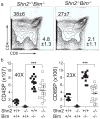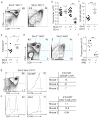Dampening of death pathways by schnurri-2 is essential for T-cell development
- PMID: 21475200
- PMCID: PMC3077958
- DOI: 10.1038/nature09848
Dampening of death pathways by schnurri-2 is essential for T-cell development
Abstract
Generation of a diverse and self-tolerant T-cell repertoire requires appropriate interpretation of T-cell antigen receptor (TCR) signals by CD4(+ ) CD8(+) double-positive thymocytes. Thymocyte cell fate is dictated by the nature of TCR-major-histocompatibility-complex (MHC)-peptide interactions, with signals of higher strength leading to death (negative selection) and signals of intermediate strength leading to differentiation (positive selection). Molecules that regulate T-cell development by modulating TCR signal strength have been described but components that specifically define the boundaries between positive and negative selection remain unknown. Here we show in mice that repression of TCR-induced death pathways is critical for proper interpretation of positive selecting signals in vivo, and identify schnurri-2 (Shn2; also known as Hivep2) as a crucial death dampener. Our results indicate that Shn2(-/-) double-positive thymocytes inappropriately undergo negative selection in response to positive selecting signals, thus leading to disrupted T-cell development. Shn2(-/-) double-positive thymocytes are more sensitive to TCR-induced death in vitro and die in response to positive selection interactions in vivo. However, Shn2-deficient thymocytes can be positively selected when TCR-induced death is genetically ablated. Shn2 levels increase after TCR stimulation, indicating that integration of multiple TCR-MHC-peptide interactions may fine-tune the death threshold. Mechanistically, Shn2 functions downstream of TCR proximal signalling compenents to dampen Bax activation and the mitochondrial death pathway. Our findings uncover a critical regulator of T-cell development that controls the balance between death and differentiation.
©2011 Macmillan Publishers Limited. All rights reserved
Figures




References
-
- Starr TK, Jameson SC, Hogquist KA. Positive and negative selection of T cells. Annu Rev Immunol. 2003;21:139–176. - PubMed
-
- Neilson JR, Winslow MM, Hur EM, Crabtree GR. Calcineurin B1 is essential for positive but not negative selection during thymocyte development. Immunity. 2004;20:255–266. - PubMed
-
- Alberola-Ila J, Forbush KA, Seger R, Krebs EG, Perlmutter RM. Selective requirement for MAP kinase activation in thymocyte differentiation. Nature. 1995;373:620–623. - PubMed
-
- Fischer AM, Katayama CD, Pagès G, Pouysségur J, Hedrick SM. The role of erk1 and erk2 in multiple stages of T cell development. Immunity. 2005;23:431–443. - PubMed
Publication types
MeSH terms
Substances
Grants and funding
LinkOut - more resources
Full Text Sources
Other Literature Sources
Medical
Molecular Biology Databases
Research Materials

